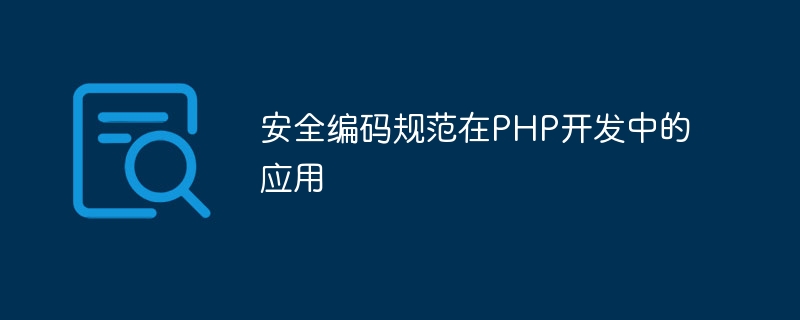Home >Backend Development >PHP Tutorial >Application of secure coding standards in PHP development
Application of secure coding standards in PHP development
- WBOYWBOYWBOYWBOYWBOYWBOYWBOYWBOYWBOYWBOYWBOYWBOYWBOriginal
- 2023-08-07 23:27:161552browse

Application of secure coding standards in PHP development
With the development of the Internet, network security issues have become one of the important challenges faced by developers and users. PHP, as a popular server-side scripting language, is widely used in web development because of its flexibility and ease of use. However, due to PHP's dynamic nature and open ecosystem, its security is vulnerable to threats. Therefore, following secure coding practices in PHP development becomes crucial.
This article will first introduce several common security threats and vulnerabilities, and then provide some secure coding standards and give specific code examples.
1. Common security threats and vulnerabilities
- SQL injection: Attackers insert malicious SQL statements into user-entered data to perform unauthorized database operations.
- Cross-site scripting attack (XSS): The attacker inserts malicious script code into the web page. When the user visits the page, the malicious code will be executed in the user's browser.
- Cross-site request forgery (CSRF): An attacker uses the victim's identity to send malicious requests to perform unauthorized operations without the user's knowledge.
2. Secure Coding Specifications
- Input verification and filtering
All user-entered data should be verified and filtered. For example, use a filter function to filter user-entered data, as shown below:
$input_data = $_POST['input_data']; $filtered_data = filter_var($input_data, FILTER_SANITIZE_STRING);
- Use prepared statements to prevent SQL injection
Prepared statements Processing statements can separate user input data from SQL query logic, ensuring that input data is not parsed as part of an SQL statement. The following is an example of using prepared statements:
$stmt = $pdo->prepare('SELECT * FROM users WHERE username = :username');
$stmt->bindParam(':username', $input_username);
$stmt->execute();- Preventing cross-site scripting attacks (XSS)
For user input and output data, HTML encoding should be performed. For example, use the htmlspecialchars function to encode the output data as follows:
$output_data = '<script>alert("XSS Attack!");</script>';
$encoded_data = htmlspecialchars($output_data);
echo $encoded_data;- Encrypt sensitive data
For data containing sensitive information (such as passwords, User accounts, etc.) should be stored encrypted to prevent leakage. For example, use the password_hash function to encrypt a password as follows:
$password = '123456'; $hashed_password = password_hash($password, PASSWORD_DEFAULT);
- Prevent Cross-Site Request Forgery (CSRF)
When handling requests involving security-sensitive operations , a unique token should be generated for each form and the validity of the token should be verified. The following is an example of using CSRF tokens:
session_start();
if ($_SESSION['csrf_token'] !== $_POST['csrf_token']) {
die('Invalid CSRF token');
}
// 执行安全敏感的操作3. Summary
This article introduces the application of secure coding standards in PHP development. Secure coding practices are an important means of protecting applications from common security threats and vulnerabilities. The security of PHP applications can be effectively improved through input validation and filtering, using prepared statements, preventing cross-site scripting attacks, encrypting sensitive data, and preventing cross-site request forgery.
However, secure coding standards are only the first step to ensure security. Continuous security testing and vulnerability repair are also important links that cannot be ignored. Only a combination of various means can ensure the security and reliability of applications.
The above is the detailed content of Application of secure coding standards in PHP development. For more information, please follow other related articles on the PHP Chinese website!
Related articles
See more- Recommendation of the 10 best PHP development tools in 2023
- What are the commonly used frameworks in PHP? Comparison of the differences between commonly used frameworks for PHP development
- What IDE is used for thinkphp development?
- What are the applications of artificial intelligence in medicine?
- PHP development api interface

